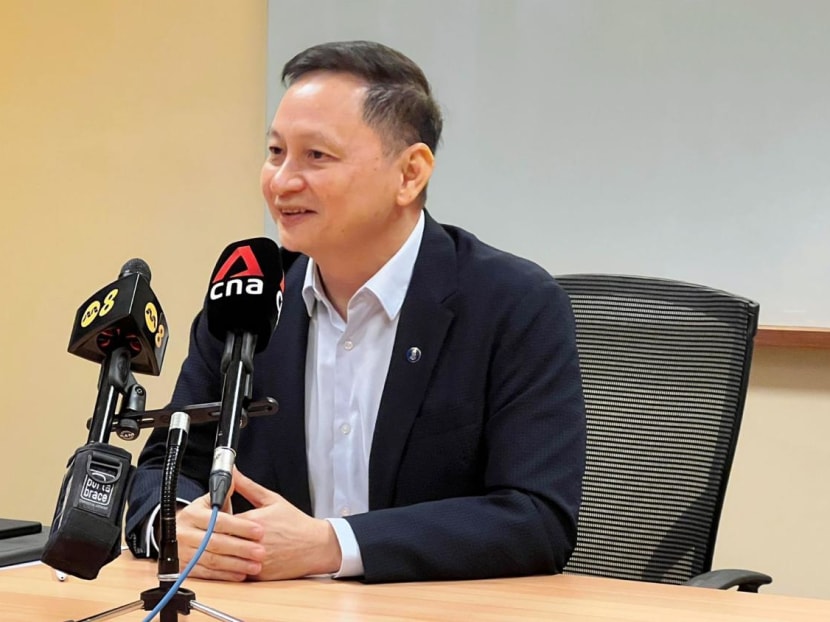‘We could have reacted faster': SIA CEO addresses criticism of economy meals, unveils unlimited free Wi-Fi on all classes
SINGAPORE — Recent public backlash over the Singapore Airlines (SIA) in-flight dining experience have taught the flag carrier that it can react more swiftly to customer feedback and look at things more speedily, said its chief executive Goh Choon Phong, as he outlined strategies to ensure that the airline continues to be a great way to fly.

Chief executive of Singapore Airlines Goh Choon Phong speaking to reporters in a roundtable interview on May 30, 2023.
- The recent public backlash over the food served in Singapore Airlines' (SIA) economy class has taught the flag carrier that it should respond more swiftly to customer feedback, said its chief executive Goh Choon Phong
- However, potential negative feedback should not deter the airline from continuing to innovate for the sake of its customers, he added
- On Tuesday (May 30), Mr Goh also announced new measures to improve customer experience, such as free unlimited Wi-Fi to virtually all SIA passengers
- He also noted how SIA has become more agile after the pandemic
SINGAPORE — The recent public backlash over the food served in Singapore Airlines' (SIA) economy class has taught the flag carrier that it should respond more swiftly to customer feedback, said its chief executive Goh Choon Phong, as he outlined strategies the airline is implementing to ensure it is still thought of as a great way to fly.
Speaking to reporters on Tuesday (May 30), Mr Goh said that the risk of things going wrong cannot deter the airline from continuously innovating to improve customer experience — which he said was what motivated the recent unpopular moves.
SIA launched a trial to use paper serviceware in economy class and premium economy class on selected flights, which drew criticism by some camps who accuse the airline of cutting corners. There were also other criticisms by passengers who observed that meals now come with fewer items.
“If it doesn't work, we must be willing to withdraw them and then do what's right by the customers. And that's exactly what we've done,” said Mr Goh.
Among the new moves that SIA is making in its effort to boost service quality is to offer free unlimited Wi-Fi for all passengers from July, he added.
He also recapped how the airline had come to report record profits by tapping the pent-up demand for travel after the pandemic.
SIA Group on May 16 reported a record annual profit of S$2.16 billion, reversing three straight years of losses, driven by strong demand for air travel that boosted revenue.
FASTER REACTION, MORE COMPREHENSIVE ASSESSMENT
Commenting on the online criticism about the leaner economy class meals being served recently, Mr Goh acknowledged that there were things that the airline could have done differently, even though they had implemented the changes after studying passenger habits.
For example, the airline noticed that a lot of the appetisers served in economy class go to waste.
At the same time, passengers indicated that they preferred more substantial main course meals. This led to the airline changing the casserole in April 2020 to ones that contained about 30 per cent more food.

As more flights resumed, the airline received feedback from passengers saying they would like to have the appetisers and a “fuller tray”, which eventually led to the airline reinstating the food items.
Mr Goh said: “If you ask me, could we have done better? I believe we could have reacted faster rather than taking as much time as we did to actually put back those items.”
Explaining the trial for paperware, Mr Goh said: “We were really thinking about increasing varieties, taste and bringing in things that we couldn't have done before.”
The specially designed paperware was able to retain moisture and heat, allowing them to offer gravy-based dishes such as laksa and mee siam that previously could not be offered, he said.
Upon reflection, Mr Goh said, it was not only important to consider the taste and quality of the food, but also the image portrayed when using paperware during in-flight services.
“Does it mean that we should not, going forward, innovate? Especially whenever we innovate we're looking at how best to make it better for customers,” he said.
“We should, I think, continue to look at innovation, but we must learn from this, that it is not a single dimensional assessment. We should also be very careful about how potentially it might be perceived.”
He added that the airline did not save money during this trial and had in fact incurred more costs as it involved the use of a special type of paper.
Mr Goh also said that for this financial year, the budget for in-flight meals has risen by about 20 per cent compared with pre-Covid times.
“We have actually planned for higher expenditure for in-flight meals, despite the fact that we are carrying fewer passengers still relative to pre-Covid,” said Mr Goh. “So, again, it's not cost cutting. It is actually providing more per passenger.”
While he could not give a breakdown of the cost increase, Mr Goh said that “it is more than just the inflationary effect”, in response to TODAY’s queries.
OTHER EFFORTS TO IMPROVE CUSTOMER EXPERIENCE
Beyond dining, Mr Goh announced that free unlimited Wi-Fi will be extended to all passengers on board flights that are equipped with such connectivity. SIA operates 136 passenger aircrafts as of May, with only seven that are not Wi-Fi enabled.
The offering will be rolled out in July and requires a customer to sign up for a complimentary KrisFlyer membership and key in the account details at the point of booking or at check-in.
Currently, KrisFlyer members travelling in Premium Economy and Economy Class are respectively offered three-hour and two-hour complimentary Wi-Fi access.
Additionally, Mr Goh said that although passenger levels are currently around 80 per cent compared to pre-Covid, SIA has bumped up its call centre manning capacity to 130 per cent.
This is to meet the high level of calls that are coming in to its service lines, many of which are from customers who would like “assurance from humans” to ensure that their itinerary is in line with the prevailing requirements at their destination, he said.
SUCCESS STRATEGY ‘NOT A NEW RECIPE’
Asked by TODAY on how sustainable it would be for SIA to continue offering services that match its premium positioning, especially given the more challenging operating environment, Mr Goh said the airline is managing with strategic cost efficiencies.
“The way we look at costs and productivity is that we do not want to cut costs where it adversely affects our customers’ experience. That wasn't and hasn't been our intention,” he said.
Instead, SIA is looking at cost efficiencies in other areas to achieve “cost advantage relative to other airlines”, he added.
Mr Goh said that in terms of unit cost, SIA is “one of the most competitive in the world” despite offering a high level of service and product.
“It is not a new recipe that we follow. We have always done so and, in fact, during the pandemic, a huge significant portion of the transformation is about how do we improve productivity and improve our workflow,” he said.
Mr Goh recapped how in the early stages of the pandemic, SIA had to raise fresh funds through rights issue and sale of convertible bonds.
"You may recall that the rights issue were priced at S$3 per share," said Mr Goh. The shares prices have since doubled, SIA's shares.
Meanwhile the company has "as a whole, redeemed almost 70 per cent" of the mandatory convertible bonds at 4 per cent return, "which is a very good return relative to what the interest rate was at that point when this structure was put in place."
"So we're very glad that our shareholders who have stuck with us have actually gotten rewarded in the process," said Mr Goh.
A reader recently wrote in to national broadsheet the Straits Times, saying that the national carrier should consider contributing part of its record profits back to the national reserves.
This was in light of its exceptionally strong financial showing and taking into account that the airline industry — including SIA — had benefited from government support packages during the pandemic.
One example of such aid is the S$500 million OneAviation Resilience Package rolled out in March 2022 that went into supporting aviation companies in three areas — manpower, cost relief and support for public health safeguards, and industry and workforce transformation.
In response, Mr Goh first acknowledged, as he did repeatedly during the interview, that SIA’s latest financial success was thanks to the support of many stakeholders.
These include its shareholders, workers and passengers, as well as the Government, which had not only extended financial support but taken decisive measures to reopen borders in a timely and safe manner.
He said SIA takes its “role in Singapore very seriously”, noting how during the depths of the pandemic the airline had reunited Singaporeans and their loved ones when no other airlines were offering flights, on top of transporting essential goods to Singapore.
He said these flights were “beyond trying to make money”.
As a company, he said that SIA, like other organisations, contributes back to the nation through taxes on its profits.
He also noted that SIA’s majority shareholder is Temasek, which is one of the entities that contribute to the Net Investment Returns Contribution that adds to the nation’s coffers.
Ending the interview on a forward looking note, Mr Goh said that SIA has emerged from the pandemic “not only more innovative and resilient, but also more agile”.
This puts the airlines in a better position to tap the further reopening of air traffic, which it will continue to monitor.
“You can be rest assured that we will actually be ready to put back capacity when the traffic recovery comes about.”











